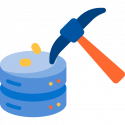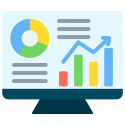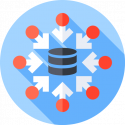
Data acquisition via web scraping
Web scraping is a sophisticated data extraction method that automates the retrieval of information from websites. Through a series of programmatically executed steps, it involves sending requests to web servers, downloading the HTML content of web pages, and parsing that content to extract specific data points. This process is instrumental in various industries, enabling businesses to gather market insights, track competitor activities, and analyze trends. By navigating the intricacies of web page structures, web scraping efficiently transforms unstructured web data into organized datasets, facilitating better decision-making. It's a powerful tool for tasks like price monitoring, content aggregation, and custom data extraction, streamlining the acquisition of valuable information from online sources.
Web scraping can be a powerful tool for various applications

Data mining
Extracting valuable information for analysis

Price Monitoring
Tracking prices of products on e-commerce sites

Content Aggregation
Collecting data for news or content websites

Competitor Analysis
Gathering data on competitors' products or services
Web scraping SEQUENCE
- Requesting the Web Page:
A script or program sends an HTTP request to the target website's server, asking for the content of a particular web page.
- Downloading the Web Page:
The server responds to the request by sending back the HTML content of the web page. This HTML content contains the structure and information on the page.
- Parsing the HTML:
The received HTML content is parsed, meaning it is processed to identify and extract the relevant data. This often involves using libraries or tools that can navigate and understand the structure of HTML.
- Data Extraction:
Once the HTML is parsed, the script or program can identify specific elements, such as text, images, links, or other data, and extract them. This could involve navigating through the HTML using tags, classes, or other attributes.
- Storing the Data:
The extracted data is then usually stored in a structured format, such as a spreadsheet, database, or other data storage solutions, depending on the purpose of the scraping.
Orientative prices
Very small project
- Single data source
- Minimal to none data cleaning
- One-time fulfillment
- Delivery format: .CSV, .XLSX
- Delivery time up to 1 week
Small project
- Single data source
- Data cleaning and reshaping
- One-time fulfillment
- Delivery format: .CSV, .XLSX, .JSON
- Delivery time 2 - 4 weeks
Middle-size project
- Multiple data sources
- Data cleaning and reshaping
- One-time or regular/periodic fulfillment
- As per customer requirements
- Delivery time as per particular project
Large project
/CUSTOM PRICE
- Multiple data sources
- Extensive data cleaning and reshaping
- One-time or regular/periodic fulfillment
- As per customer requirements
- Delivery time as per particular project
